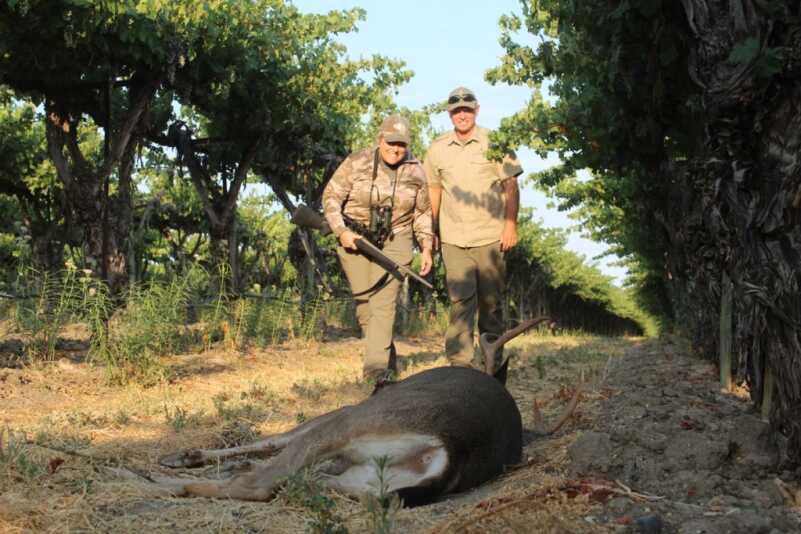
Mossberg’s Linda Powell and Ryan Newkirk of Steinbeck Vineyards approach a gorgeous vineyard buck. A big, heavy-antlered fork-horn, this buck would never grow any more points; many of these deer are two-by-twos at full maturity—but look at the antler mass!
On August 11 a friend of mine from back East texted me and I responded that I was deer hunting. “Boddington,” he came back, “it’s August…around here we call that poaching!” On the surface, it seems crazy. Here on the Central Coast, August temperatures soar above 100 degrees and wildfires are headline news. Even so, it’s deer season! The “coast zone” rifle deer season opens the second Saturday in August. This year opening day was the 11th; it could open as early as August 8…but never later than the 14th. This is the earliest rifle deer season in the Lower 48!
If you get a buck a long way from a road you better carry a pack frame; the days heat up quickly, and it can become a footrace to the cooler. That said, it isn’t all that bad. Daytime temperatures are high, but humidity is low and the Central Coast has one of North America’s greatest temperatures swings, an average of 39 degrees between high and low. So if it’s 90 at noon it will be down in the 50s at dawn, and usually cools in the late afternoon.
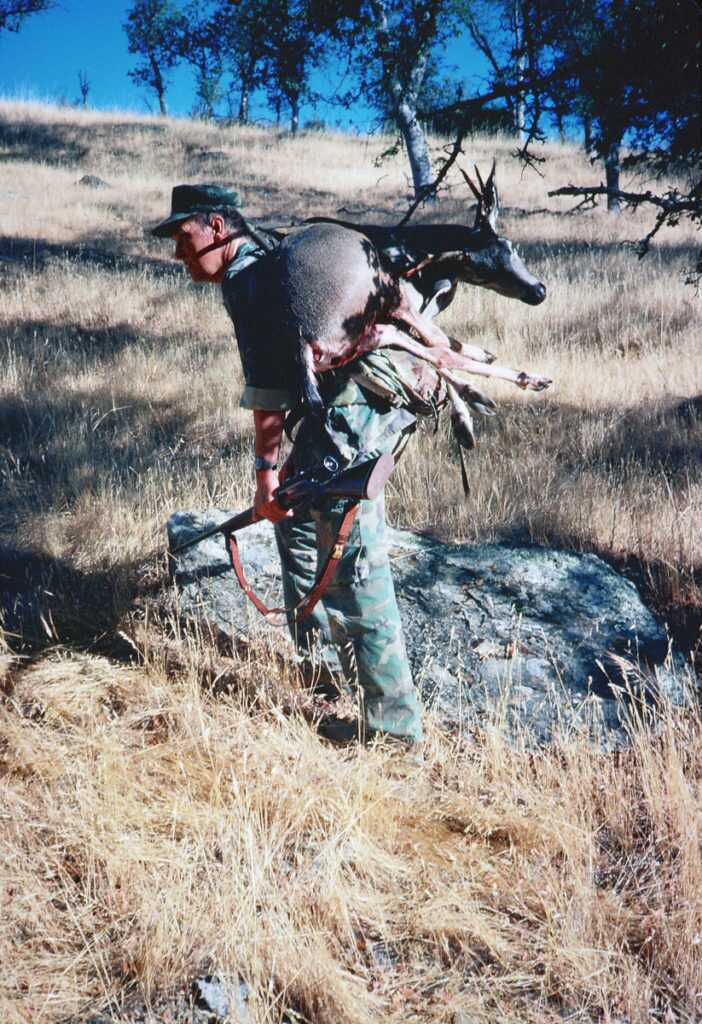
Middays heat up quickly, so if you’re a long way from a road you need to get your deer out as quickly as possible. These are usually small-bodied deer; packing a field-dressed deer on a pack frame is often practical.
The hunting day is short; you get a few hours of deer movement in the morning and evening. There can be some daylight movement to and from water. I’ve taken a couple of good bucks at blistering noontime…but often I don’t worry about it, instead napping away the hot hours or, God forbid, getting some work done.
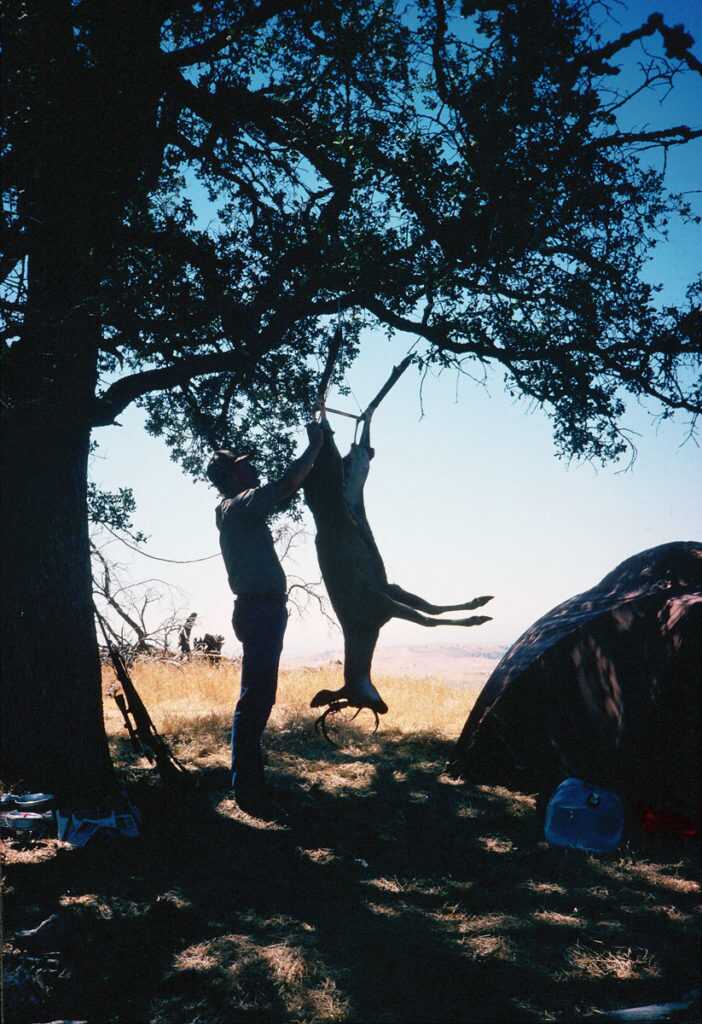
Although the Central Coast has high daytime temperatures during the August season the temperature swing between high and low averages almost 40 degrees and it cools off quickly at night. A buck taken in the afternoon can be hung overnight, but a morning buck needs to go in a cooler!
Why August?
“Because it’s always been that way.” I first hunted the Central Coast when I was a young lieutenant down at Camp Pendleton in the mid-70s. The August season had been in place for decades. Unlike much of California, the “coast zone” offers over-the-counter tags (no drawing), with a second tag available. It’s bucks only and, also long traditional, a “legal buck” must have a fork in the upper half of one antler
Much of the coastal hills are blanketed by thick chaparral brush and summers are long, hot, and dry. Deer densities are low, and antler growth is modest. At full maturity, many bucks never go past two points per side and four-point antlers are rare. Honest, the hunting is difficult enough that just about any legal buck is prized! So far this probably doesn’t sound spectacular, but along the Central Coast this is “our deer season” and we cherish it.
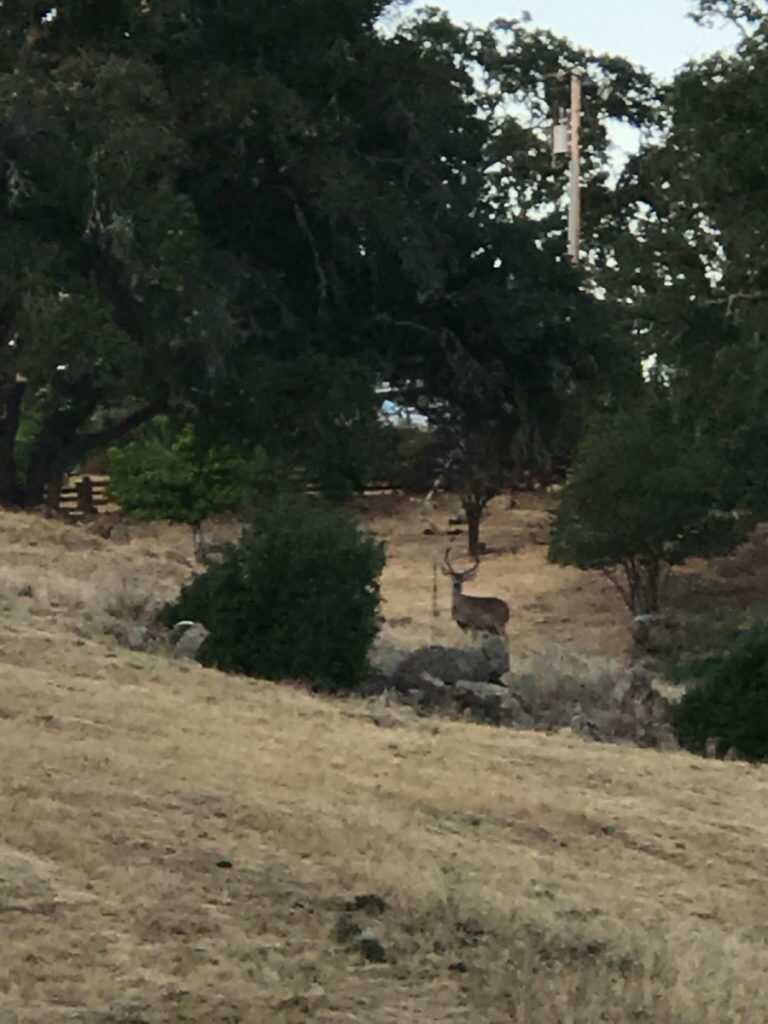
Donna and Craig Boddington surprised this buck while out hiking before the season. This is a great buck for the coast zone, and he still has some growing to do…but bucks like this are few and far between!
There are benefits. It’s a long rifle season, running into late September. This is important, not just for time afield but because these deer go into full rut about September 15, the earliest deer rut I know of. The tail end of our coastal season is almost certain to catch major rutting activity. These deer enjoy a mild winter, with November rains greening things up. Their major stress period is the hot, dry summer; they rut early so the fawns can be born in the mild spring.
For we coast zone deer hunters this means that the end of the season is usually the best. The weather cools down, and bucks come out of the thickets and cruise for does. The last week of the season is a time when unknown bucks appear out of nowhere; this is when some of our bigger bucks are taken. At the beginning of the season many bucks are still in velvet, but by early September most bucks are in hard antler.
Coastal Bucks
Exactly what these coastal deer are is a matter for conjecture. California has the most mule deer subspecies: Columbia blacktail to the northwest; Rocky Mountain mule deer to the northeast; California mule deer to the southeast; and the little-known southern mule deer from Orange County (below Los Angeles) south into Baja. We call our deer blacktails or “coastal blacktails.” In appearance, they are closest to Columbian blacktail, but there is California mule deer influence; in some individuals, it can be seen in ears that are a bit too big, or tails that don’t have quite enough black.

This is a fork-horn or “two-by-two.” This is not an unusual configuration for many coastal bucks at full maturity. Many never grow more than two points, sometimes with eyeguards and sometimes not—and very few reach the classic four-by-four mule deer configuration.
Taking the strictest approach, Boone and Crockett’s southern boundary for Columbia black-tailed deer lies to the north, so B&C considers our deer “mule deer.” Because of habitat and genetics, it’s unthinkable that one of our coastal deer could ever grow antlers large enough to be a record-class mule deer. It’s also unusual for one of our deer to achieve the Boone and Crockett minimum for Columbian Blacktail. We think of outside spreads of 17 or 18 inches as wide, and only occasional bucks reach the low 20s. Clean “four-by-fours” are very rare; our very largest bucks may be “four-by-threes,” “three-by-threes”—or even giant fork-horns.
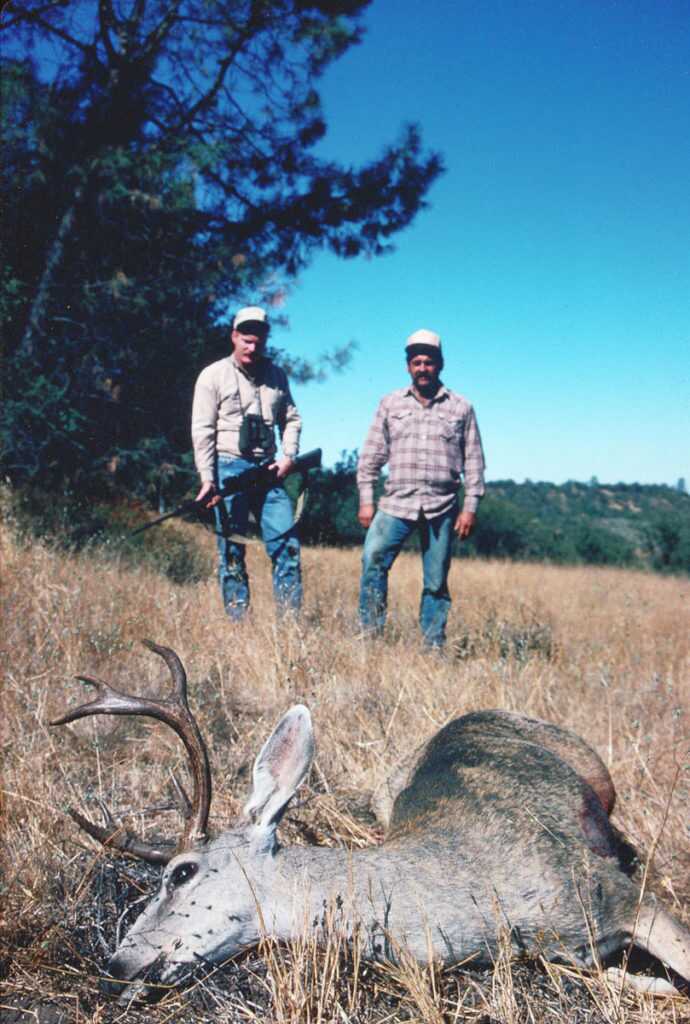
This three-by-three was taken near a waterhole on blistering midday. With long August daylight there is usually some daytime movement…but not much! This buck is a three-by-three, a nice buck for the area.
Wherever you hunt deer it’s wise to hunt them for what they are, not what you wish them to be! I doubt the deer really care what we call them, but since they received no recognition anywhere else, in their record-keeping system Safari Club International accepts them as Columbian black-tailed deer. I usually just call them “coastal blacktails” but, by any name, I like to hunt them.

This “spike-fork” is fairly typical of many coast zone “legal bucks,” meaning a fork in the upper part of one antler. There are usually bigger bucks around, but on public land a legal buck is a genuine prize.
Places to Hunt.
Finding good areas to hunt these deer isn’t easy. There is plenty of National Forest nearby and some patchwork BLM, but deer densities are not high. Thanks to water and agriculture concentrations are mostly on private land. We’ve lived in the Central Coast for 25 years; like most local hunters I’ve developed access, but it comes and goes so I’ve tried it all, from public to private. We are also in the heart of California’s feral hog hunting; most of our local outfitters also offer deer hunting and control the majority of the private land tule elk tags.
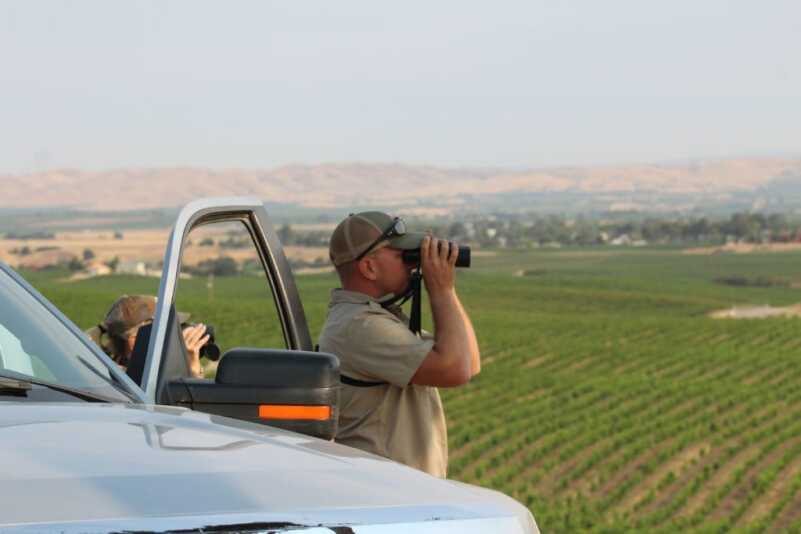
Ryan Newkirk and Donna Boddington glassing for deer in Steinbeck Vineyards. Regrettably, many vintners fence out deer; the Steinbeck family manages their wildlife and accept some depredation. The tradeoff: They are producing really nice bucks!
The last few decades have seen major growth in the Central Coast’s wine industry. For the 2018 deer season, Donna and I had a new and unique opportunity, joining Mossberg’s Linda Powell, Riton Optics’ Brady Speth, and fellow writers Andrew McKean and Bryce Towsley to hunt deer literally among the grapevines at Steinbeck Vineyards. Many vineyards are game-fenced, and few vintners tolerate losses from wildlife. The Steinbeck family does, managing their deer along with their grapes.

Looking for deer in the vineyards is literally row-by-row…and once found they can disappear in an instant.
Looking for deer from row to row was different, but the deer love it, and with abundant nutrition both body and antler size are considerably bigger than what we’re used to with our local deer. Donna shot a real monster on opening morning, the rare four-by-four, still in velvet but fully formed underneath, one of the best bucks I’ve seen on the coast zone. After six days we were hoping for just one more buck to fill us out. It doesn’t get much better than that…and these vineyard deer yield some of the best venison I’ve tasted!
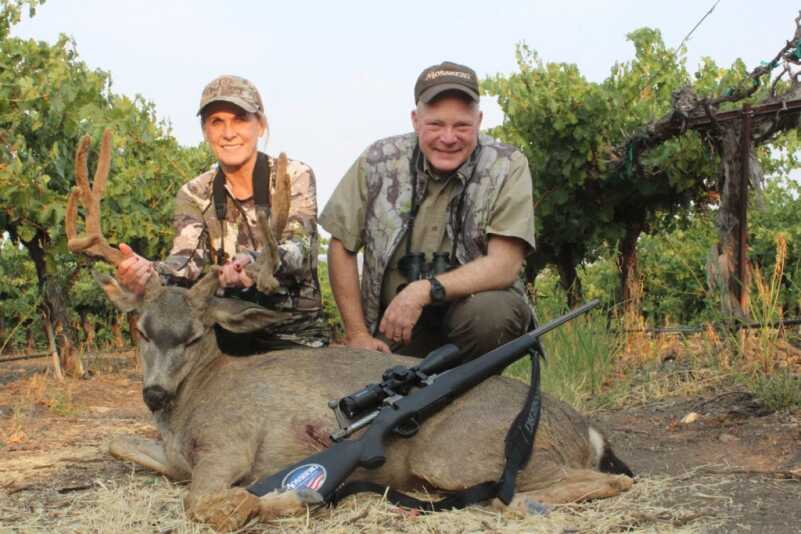
Donna Boddington took this buck on opening day 2018, August 11 in Steinbeck Vineyards. Still in velvet, this clean “four-by-four” is a huge coast zone buck. Donna used a Mossberg Patriot in 6.5mm Creedmoor topped with a Riton scope.
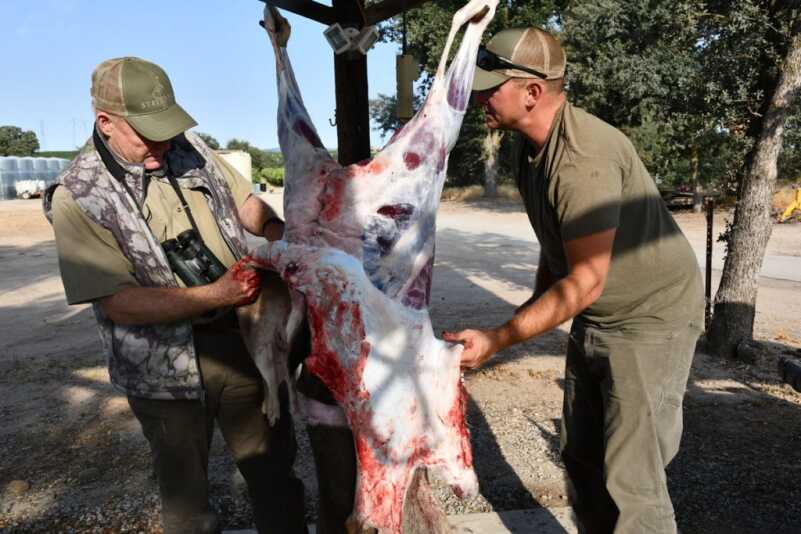
Boddington and Ryan Newkirk skinning a buck taken from Steinbeck Vineyards. Apparently these deer appreciate good wine; this is an extremely large-bodied buck for coastal deer, and the layer of fat is unusual. Vineyard bucks are exceptionally tasty!


Good stuff ! Thx, Sarge
Just curious ,,if he’s been so widely published then why did he file bankruptcy ?
I think it’s important to point out that very large old bucks (think the largest racks) are important NOT to take because 1) the meat is not the most tender, and 2) recent studies show (and confirm older studies with newer equiptment) that it is the Old Bucks (of virtually any animal – particularly herding animals like deer) carry the best genes for the species, sire more offspring, who tend to live longer. In practice this means that leaving the oldest male of a heard means that in the future you will have MORE middle age bucks to harvest – and those are generally LARGER than animals sired by younger males. *AND* By leaving the older males, you end up with more tender venison, and MANY more and larger middle aged bucks for future hunts. NOT taking that shot is not an easy thing, but if you resit, and ask your buddies to resit, in about 4-5 years there will be more deer of larger size to hunt. Taking that Old Buck messes with the gene pool, decreases the size (in number and in weight) of other males in the herd, TENDS to decrease antler size, and gives you a larger more healthy herd, with more ‘point’ on their antlers — whether you count them by Western Standards or Eastern Standards.
By leaving the oldest bucks, it’s like leaving the oldest fish or birds — you don’t cause irreparable changes in the gene pool, you help alleviate a population ‘crash’ (think the cod crash of the Eastern Seaboard or the Salmon crash along the West Coast). While hunting plays only a SMALL part in a complex system, harvesting the oldest of the animals seems to be one of the MOST VITAL elements for a good herd, and maintaining an adequate supply of larger, more healthy animals that can be taken. It doesn’t happen over night – but it WILL happen.
While most hunters never think of things like this- by NOT taking the oldest when you have it in your sights – you are making a sacrifice. ‘Sacrifice’ means ‘To Make Sacred’ – So, in a way, by NOT sending that round downrange you have preformed a sacred act in preserving the vitality and health of a herd.
I won’t say DON’T shoot, that’s your decision – but I’m going to ask you to think about the future of the game animal you are hunting before you pull the trigger. You can help build larger more healthy middle age bucks in the future – thus giving you more choices or chances to ‘take’ a buck in the future – OR you can help keep the deer smaller, less healthy, and at a lower population if you DO pull that trigger. One buck won’t make no never mind in the Big Scheme of Things – but 100+ bucks can make a HUGE difference during it’s lifetime.
There are many reasons for this, but the main one is the over harvest of the oldest, strongest, and most prolific breeders of a population, thus your culling shapes the size, stamina, health, and gene pool of the herds you hunt. Me? I don’t take large bucks, I like tender meat, and I like to think that I make it possible for my grand kids to hunt a large population of deer significantly larger and healthier than the herd I now hunt. As a kid Grandpa and I used to go out and poach deer because we were poor – and the herds were huge and the deer were all large. Today (more than 50 years later) I see VERY few large deer, and a HUGE overabundance of medium, rather thin males compared to the middle 1950’s and early 1960’s. A bit of reading confirms what grandpa told me about hunting – and about raising livestock – the concepts are basically the same – keep the oldest most healthy and eat the rest. From chickens to goats to rabbits I saw what leaving the oldest to mate could do to an entire population.
Just give it a thought. Wait 3-5 years and have LOTS of LARGE middle aged males who are far more tender, — or pull the trigger, and never see that abundance of food grazing meadows, or drinking at their water source. The future is in YOUR hands. I’ve already grasped it, I hope you join me. It’s not a ‘DON’T HUNT’ kind of thing, it’s more like HUNT WITH A BRAIN AND THOUGHT FOR TOMORROW kind of thing. Even if you just think about this, and pull the trigger, you’ve taken a larger step to large healthy herds of the future than you imagine. DON’T pull the trigger, and you are now part of healthier, larger, happier bucks with more ‘points’ future.
I can see how that could save on the cost of marinate.
Great article. Love reading these. BUT…
That pic showing an entire animal strapped to a hunter’s back!
And to add insult to injury? No orange anywhere! How dangerous could THAT be!?
Everything might be legal, and probably is, but “I” wouldn’t do it.
excellent
I always enjoy reading Craig’s story’s..
CONGRAD! HE IS A BEAUTY? BON A PETTIT! BON TON ROULET!